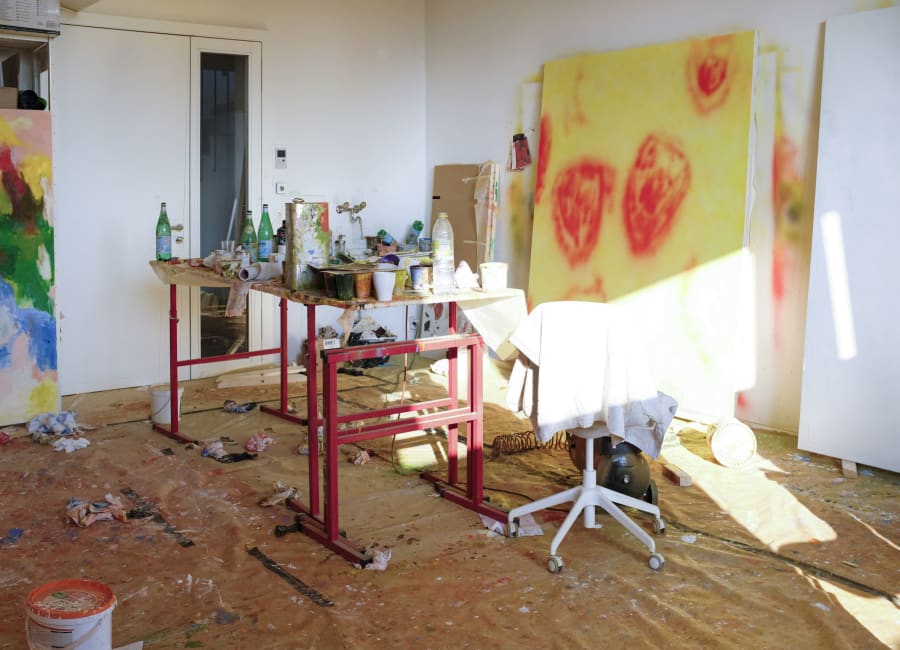Built in the middle of the 18th century, the Grand Chalet in Rossinière, with its 113 windows and scenic surroundings, brings to mind at least two of Switzerland’s defining features: cheese production – for which it was built – and alpine charm. I had left early to take one of the trains that ride up into the region of Pays-d’Enhaut from Lake Geneva before continuing on toward the Bernese Alps, so I had time to check out other historical sites in the village.
At the Balthus Chapel, I watched a few short films about the chalet, which has national heritage status, and the painter Balthus (1908-2001), who lived there from 1977 until his death. One of the videos, filmed in the last few years of his life, shows a joint celebration for the artist’s 88th birthday and his daughter Harumi’s 22nd. The video captures well-known guests (including the musician Bono and the actor Tony Curtis) and conversations where the painter talks about his inspirations (Bonnard, Piero della Francesca), his friends (Artaud, Camus), and even the painting that first provoked his controversial reputation, La leçon de guitare (1934).
I then made my way to the impressive building in which Balthus spent his final years, where I was welcomed by his widow, the artist Setsuko Klossowska de Rola. She still lives in the Grand Chalet, along with her daughter Harumi, her son-in-law Benoît Peverelli (a photographer), and her two grandchildren. Thadée Klossowski de Rola, the son of Balthus and his first wife Antoinette de Watteville, also lives here.
It was in 1976, while drinking tea in the Grand Chalet, that Setsuko and Balthus were struck by the same desire to buy it. It had been a hotel for a little over a century, and with few amenities, it no longer met the standards of the time. The owner wanted to sell. The couple had already bought the Castello di Montecalvello, situated between Florence and Rome (Balthus had been director of Rome’s Villa Medici from 1961 to 1976). But Italy’s sirocco wind occasionally reawakened the malaria that Balthus had contracted during military service in Morocco, and the doctor had advised him to go to Switzerland. For Setsuko, the Grand Chalet evoked the wooden houses of her Japanese childhood. The gallerist Pierre Matisse loaned them some money. ‘I will work,’ Balthus had said, simply.
Pour le peintre Thomas Huber (né en 1955), le lac devient un lieu de retour aux sources. « Lago Maggiore », le titre de son exposition personnelle au MASI Lugano qui s’est tenue en début d’année, a marqué un tournant dans son travail. Les plus grandes toiles exposées sont débarrassées des éléments architecturaux qui définissaient ses œuvres antérieures. L’une d’elles, intitulée Am Abend (2023) et réalisée dans un format panoramique de 3 mètres de long, offre une expérience presque immersive du lac au crépuscule. Montrée d’un point de vue en hauteur, l’étendue d’eau est encadrée de collines fortement stylisées et de formes rondes évoquant des arbres. Les silhouettes des bâtiments et les lumières scintillantes sur les rives induisent une certaine contemporanéité, tandis que le motif de la vue sur le lac est exécuté avec une perfection épurée qui exprime l’intemporalité. De retour dans la région frontalière entre la Suisse et l’Italie après avoir passé plusieurs dizaines d’années à Berlin, Thomas Huber fait preuve d’une dévotion et d’une observation minutieuse du paysage local qui répond à un besoin universel de se sentir ancré et chez soi quelque part dans le monde.
Nowadays, the Grand Chalet is a living home, restored with respect for its history. Its residents are all artists. Harumi works on her sculpture and jewelry design in the small former chalet of a shooting club located on the premises. To the side of the sitting room, where we had been drinking tea, the dining room has been set up in a room once occupied by Victor Hugo. On the other side, Setsuko has her studio, where she creates delicate still life paintings, and where she is struggling to finish a large portrait of a hard-eyed Balthus. ‘That was how he looked at his canvases, even though he would touch them with his paintbrush like stroking a baby’s skin.’
Setsuko works on her ceramics in Paris, but she showed me some of her white, thick-trunked trees in the chalet’s cellars. She is represented by Gagosian, which is preparing a Balthus catalogue raisonné. Next door is the huge room built to store cheese. It was used as a dining room by the hotel before hosting art exhibitions up until the 2000s. Now, it is used as a playroom and music room for the children.
Elisabeth Chardon is the co-editor of the quarterly publication La Couleur des jours. She was also the editor in charge of visual arts at the Swiss daily broadsheet Le Temps, with which she still collaborates.
English translation: Catherine Bennett.
First publication: June 23, 2023.
Caption for full-bleed image: Grand Chalet de Rossinière. © Alain Saint-sulpice.


